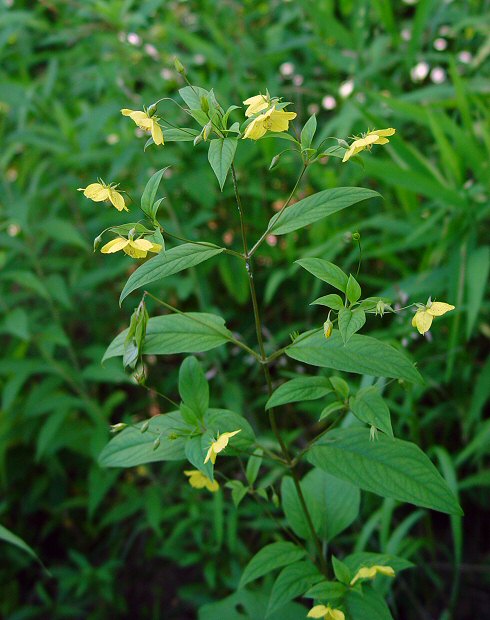Lysimachia ciliata L.
Fringed Loosestrife

Native
CC = 5
CW = -3
MOC = 65
© DETenaglia
Lysimachia ciliata L.Fringed Loosestrife | |
 |
Native CC = 5 CW = -3 MOC = 65 |
© DETenaglia |
|
Family - Primulaceae Habit - Perennial forb with long, slender rhizomes.
Stems - Strongly ascending to erect, to 1.2 m, 4-angled, relatively stout, unbranched or branched toward the tip, glabrous or minutely glandular-hairy toward the tip, especially near the nodes.
Leaves - Opposite, petiolate, decussate. Petioles well-defined, 1.0-5.0 cm long, somewhat flattened, narrowly winged, the margins evenly pubescent with long, spreading hairs along the entire length. Leaf blades 3-13 cm long, 2-5 cm wide, ovate to broadly lanceolate, rounded, angled, or occasionally shallowly cordate at the base, angled or somewhat tapered to a sharply pointed tip, the margins short-hairy, the surfaces lacking gland dots, the upper surface dark green to green, glabrous or nearly so, the undersurface light green, sparsely short hairy or glabrous; secondary veins evident.
Inflorescence - Axillary pedunculate flowers from upper leaf axils. Peduncles 2-5 cm long, minutely glandular-puberulent. Flowers nodding.
Flowers - Calyces mostly 5-lobed, the lobes 4-9 mm long, narrowly triangular to lanceolate, not gland-dotted, sometimes reddish-veined. Corollas mostly 5-lobed, the lobes 5-12 mm long, obovate, bluntly pointed at the tip or short-tapered to a minute, sharp point, the margins sometimes somewhat uneven or toothed, yellow, densely glandular and with reddish markings on the upper surface toward the base, lacking purple spots or lines. Stamens 5, shorter than the corollas, the filaments 2-3 mm long, not fused into a basal tube, glandular-hairy. Staminodes 1 mm long, alternating with the stamens, slender. Anthers yellowish, 2.5-3.0 mm long. Ovary superior, green, globose, 1.5 mm in diameter. Placentation free central. Styles 3-4 mm long.
Fruits - Capsules 3.5-6.5 mm long, broadly ovoid to globose, dehiscing by 5 valves. Seeds 1.9-2.2 mm long, irregularly elliptic, oblong, or rhombic in outline, triangular in cross-section, dark brown to black.
Flowering - May - July. Habitat - Streambanks, swamps, pond margins, sloughs, bottomland forests, bottomland prairies, moist swales of upland prairies, ditches, levees, railroads, and roadsides. Origin - Native to the U.S. Lookalikes - L. lanceolata, L. hybrida Other info. - This plant is scattered across Missouri, less commonly in the north-central region of the state. It is also found across most of the continental U.S., most commonly in the northern 2/3 of the country, also ranging into Canada. It is recognized by its characteristic flowers, which are somewhat nodding, yellow with abrupt points at the tips of the petals and a reddish glandular region toward the center, and by the petioles with distinct stout hairs all along their lengths. It is differentiated from its close lookalike L. lanceolata by having relatively wide leaves (main leaves up to 2" wide), and from L. hybrida by having petioles which are evenly hairy rather than hairy only below the midpoint. The plant is most commonly found in moist to wet areas; however, it occasionally occurs in places which at least appear quite dry. It is easily grown from seed and would make a good garden subject. Photographs taken in Brown Summit, NC., 6-10-02, and at Pultite Spring, Shannon County, MO., 6-27-04 (DETenaglia); also at Dresser Island Conservation Area, St. Charles County, MO, 7-22-2013, Little Lost Creek Conservation Area, Warren County, MO, 6-9-2017, and at Big Cane Conservation Area, Butler County, MO, 6-15-2023 (SRTurner). |